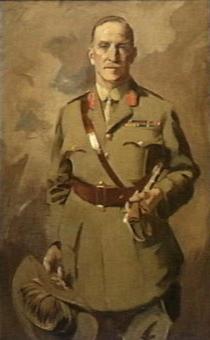Harry Chauvel
| Sir Henry George Chauvel | |
|---|---|

Lieutenant General Sir Harry Chauvel
1919 portrait by James Peter Quinn (1870–1951) |
|
| Born |
16 April 1865 Tabulam, New South Wales |
| Died |
4 March 1945 (aged 79) Melbourne, Victoria |
| Allegiance | Australia |
| Service/branch | Australian Army |
| Years of service | 1884–1930 |
| Rank | General |
| Commands held |
Volunteer Defence Corps (1940–45) Chief of the General Staff (1923–30) Desert Mounted Corps (1917–19) Desert Column (1917) Anzac Mounted Division (1916) 1st Division (1915–16) New Zealand and Australian Division (1915) 1st Light Horse Brigade (1914–15) |
| Battles/wars |
Second Boer War |
| Awards |
Knight Grand Cross of the Order of St Michael and St George Knight Commander of the Order of the Bath Mentioned in Despatches (11) Grand Officer of the Order of the Nile (Egypt) Croix de guerre (France) |
Second Boer War
First World War
General Sir Henry George Chauvel, GCMG, KCB (16 April 1865 – 4 March 1945), more usually known as Sir Harry Chauvel, was a senior officer of the Australian Imperial Force who fought at Gallipoli and during the Sinai and Palestine Campaign in the Middle Eastern theatre of the First World War. He was the first Australian to attain the rank of lieutenant general and later general, and the first to lead a corps. As commander of the Desert Mounted Corps, he was responsible for one of the most decisive victories and fastest pursuits in military history.
The son of a , Chauvel was commissioned as a second lieutenant in the Upper Clarence Light Horse, a unit organised by his father, in 1886. After the family moved to Queensland he was commissioned as a second lieutenant in the Queensland Mounted Infantry in 1890, and saw service during the 1891 Australian shearers' strike. He became a regular officer in 1896, and went to the United Kingdom as part of the Queensland contingent for the 1897 Diamond Jubilee of Queen Victoria. In 1899 he commanded one of two companies of Queensland Mounted Infantry that were Queensland's initial contribution to the Boer War. After the war, he was closely involved with the training of the Australian Light Horse.
...
Wikipedia
